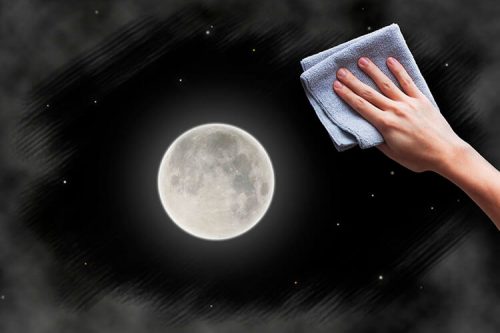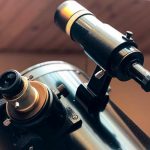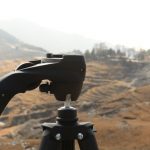How To Clean A Telescope Mirror
If you want to know how to clean a telescope mirror, then you probably have some concern there’s an accumulation of dirt or dust on your mirror. If you do have some dirt or dust on the mirror and cannot view celestial objects as clearly as you once were, it feels very frustrating.
There’s no getting around it, the optics of your telescope will get dirty over time. The time we’re talking about should only be every 5 to 10 years.
Before we discuss how to clean a telescope mirror, look at how you can prolong the time between cleanings.
Two essential parts of the process are keeping the lens cap on when you’re not using the telescope and find a small container that will hold your eyepiece holder. If you have misplaced the lens cap, you can buy a new one or just make your own. As long as it covers the lens and is held in place securely, that’s all you need.
When your telescope is not in use, stand it pointing near enough towards the ground. Doing this prevents any dust from landing on the lens. You can buy cheap containers for your eyepieces, readily enough.
Follow our guidelines for the easy way to clean your telescope mirror.

How To Clean Your Refractor Telescope Lens
You need to proceed with caution when cleaning a telescope lens. It’s inadvisable to use any household detergents; they’ll cause damage to the lens.
A very soft brush for this purpose is one made of camel hair. You will be able to buy one from a good camera store. The brush needs to be ultra-soft, so it doesn’t leave any scratches behind.
Another recommendation is to use an air blower. You’ll still need to finalize the cleaning with a lens solution, but the blower will get rid of most of the dust first.
The Best Cleaning Solution For Telescope Lenses
If you’re finding a few stains are still hanging around, you can try a cleaning solution of isopropyl or methyl alcohol. You might also try a lens pen. Use the brush to clean the dust from the lens, and then use the other end of the pen where the soft cleaning pads will remove grease or fingerprints. They do work well, but you still might need the air blower.
Don’t apply the cleaning solution directly to the lens. Apply it first to a cleaning pad of pure cotton.
How To Prevent Your Telescope Lens From Getting So Dirty
As we pointed out earlier, a good lens cap is essential.
Try not to accidentally touch the lens of your telescope when you’re using it. The natural oil in your skin will damage the optical coatings eventually. If you do touch the lens, then wipe it off as soon as you can. Try to use the lens cleaning solution we just mentioned.
If dirt or dust happens to get inside the lens, then that’s the time to turn to a professional for cleaning.

How To Clean Your Reflector Telescope Mirror
A reflector telescope uses two mirrors and not lenses for viewing and focussing light. To clean the mirrors is not the same as cleaning your lens. To get to the mirrors, it requires breaking down the telescope. If you have never done this before, it can seem a daunting task, and you shouldn’t contemplate the job unless your mirrors are in real need of a clean.
There are several steps you need to take to accomplish the clean:
- The primary mirror’s cells are attached to the end of the telescope by screws; these need to unscrewing first.
- Pull out the cell, and the mirror will be inside.
- The mirror will be kept in place by some clips. Undo these and take out the mirror, do not accidentally touch the surface.
- There is a holder in the front of the tube, which contains the secondary mirror. Remove the holder and take out the mirror.
- You’ll now need to take both mirrors to where you can wash them.
- If you make use of your kitchen sink, make sure you have given it a good clean while removing anything in your way. You should have done this before you start dismantling your telescope.
- Put a towel into the bottom of the sink and carefully place the mirror on the towel, ensuring the mirror is face-up.
- Turn on the tap so warm water flow hits the mirror, not a great blast of water, just a gentle flow is necessary.
- Submerge the mirror altogether. Put a few drops of washing soap into the water. Not a lot, no bubbles. Slowly swill the mirror around in the slightly soapy solution.
- Repeat this process with the secondary mirror.
- Lean both mirrors in a horizontal position against the wall or a drying rack.
- Empty the sink.
Stage Two
- Put warm water in the sink again and add some soap. Once again, no bubbles.
- Take some soft cotton balls. Submerge the mirror into the solution of soapy water. Using your fingertips on top of the cotton balls, gently wipe the mirror.
- Repeat until the mirror is spotless; use a cotton ball one time only.
- Do the same process with the secondary mirror.
Stage Three
- Drain the sink.
- Using distilled water, pour it over both mirrors. Don’t use the water sparingly.
- Dry each mirror gently with a clean, dry lint-free microfiber cloth.
Notes:
- You should clean the mirrors individually, not together. You must avoid them scraping or banging together.
- Don’t rub wet cotton balls across the surface of the mirror. Only when the cotton wool balls are wet from the soapy solution.
- Remember, after you have put the mirrors back into your telescope, it will require collimation.
- When the mirrors are air-drying, we speak about, make sure the mirrors are upright and in no danger of toppling over.
In Conclusion
Cleaning your telescope mirrors is not a job you should take lightly. And remember, after you have put it all back together, you will need to collimate your telescope again. So that might be enough to put off some people, especially if trying to collimate your telescope is something you would rather avoid.
However, if you’re determined to go-ahead, we hope this article on how to clean a telescope mirror has been useful.



















